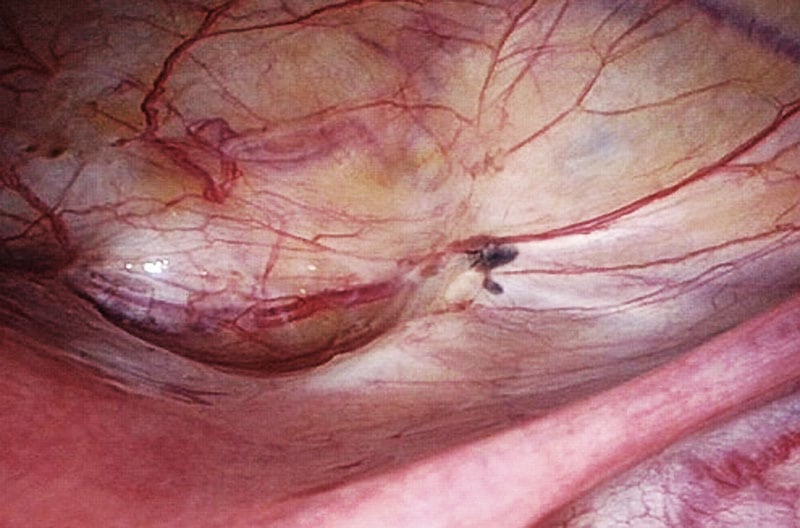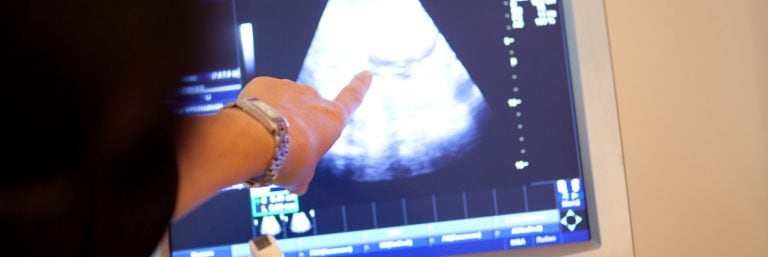What is endometriosis?
In endometriosis, tissue similar to that of the lining of the uterus (Latin: endometrium) appears in the lower abdomen outside the uterus and settles on various organs, e.g. on the uterus, peritoneum, fallopian tubes, ovaries, bladder or intestines. In very rare cases, other organs are also affected, such as the lungs.
In most cases, these endometriosis foci are influenced by the hormones of the monthly cycle. Thus, the foci can grow cyclically and bleed. This results in inflammatory reactions, the formation of cysts and the development of scarring and adhesions in the abdominal cavity. This can manifest itself in painful symptoms depending on the timing of the menstrual cycle. Endometriosis is also one of the most common causes of infertility. But:
Pain during the period is not the norm!

Why do so few women know about it?
For years, the so-called “women’s problem” was played down and trivialised. Yet girls and women are affected from their first period until beyond the menopause.
Until a definitive diagnosis is made, patients in Germany still suffer from the symptoms for between 7-11 years. Unfortunately, the disease is still unknown to many women. Many women think that they have to live with the pain during menstruation. “It’s just normal” and “it will get better after the first child”. During this time, the endometriosis can grow to such an extent that many women’s quality of life is and remains severely impaired by the pain, and the resulting adhesions can lead to unwanted childlessness.
Endometriosis is not only an immense human problem, but also a serious economic problem, the extent of which is underestimated in modern Europe in the 21st century due to the traditional image of women.
What complaints can endometriosis cause?
Endometriosis is a disease that can show a very inconsistent clinical picture. That is why it is also called the “chameleon” among gynaecological diseases. Due to the unspecific symptoms, misdiagnoses occur time and again, which is very stressful for the affected woman, not least because of the labelling as “psychologically unstable or superimposed”.
Often the symptoms are not in direct proportion to the severity of the disease. This means that small findings can cause great pain. However, there are also endometriosis lesions without a tendency to grow and without disease value.
The main symptoms of the disease are
1. Pain
- Period pains are typical and can lead to feeling ill, taking heavy medication and being unable to work.
- Pain during bleeding (dysmenorrhoea)
- Sudden fainting spells associated with menstrual pain
- Chronic abdominal pain
- Abdominal, back and lower back pain, sometimes radiating to the legs, before and during menstruation
- Pain during and after sexual intercourse (dyspareunia)
- Pain, bleeding and cramps during bowel movements / urination (dyschezia / dysuria)
- Pain during ovulation
2. Unfulfilled desire to have children
- Unwanted childlessness is an increasingly common symptom as the disease progresses. About 30-40% of women with endometriosis are affected.
3. Bleeding disorders
- Heavy and/or irregular menstrual bleeding.
4. Uncharacteristic symptoms
- Fatigue and exhaustion
- Increased susceptibility to infections
- Back pain
- Diarrhoea and / or constipation and other intestinal disorders
- Increased occurrence of allergies and other autoimmune diseases
If you have this or a similar combination of symptoms, talk to your doctor about endometriosis. Don’t be afraid to get a second medical opinion as well.
Am I an individual case? How common is endometriosis?
Endometriosis is the second most common benign disease in women. According to conservative estimates, it affects about 10% of sexually mature women. Endometriosis is responsible for up to 80% of chronic lower abdominal pain and is the cause of fertility problems in a good 30-40% of our fertility patients. In Germany alone, about 2 million women are affected by endometriosis.
How does endometriosis develop? Why do I have endometriosis?
The causes of endometriosis are still unknown today, although the disease was described by the doctor Rokitansky as early as 1861. There are numerous theories, but none of them can explain all the phenomena of endometriosis. Experts therefore now agree that many factors can contribute to the onset of the disease and its progression. The disease seems to be hormone-dependent and therefore affects 98% of women up to the menopause.
The following are discussed for the development of endometriosis:
- Reflux of menstrual blood through the fallopian tubes into the abdominal cavity (“retrograde menstruation“) and “implantation” (growth) of the tissue parts elsewhere, or
- local carry-over of the mucous membrane during operations on the uterus and the spread of the endometrial cells via blood and lymph channels.
- Hereditary predisposition (genetic disposition). Did your mother already have painful menstrual bleeding? Do you have other family members who have been diagnosed with endometriosis?
- Immune system. A compromised immune system can promote the onset or progression of the disease.
- Environmental influences can have an impact on the development of the disease.
Today it is assumed that the development of endometriosis is a multifactorial process – because no theory alone can satisfactorily explain the development.



